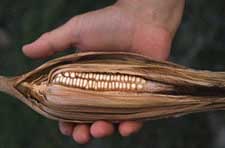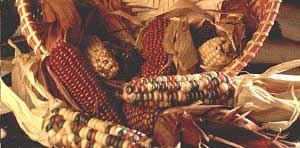Nature
November 29, 2001
Vol. 414, pp. 541-543
Transgenic DNA Introgressed Into Traditional Maize Landraces in Oaxaca, Mexico
David Quist and Ignacio H. Chapela
Department of Environmental Science, Policy and Management
University of California
Berkeley, California 94720-3110, USA
(Correspondence and requests for materials should be addressed to I.H.C. e-mail: ichapela@nature.berkeley.edu.)
Concerns have been raised about the potential effects of transgenic introductions on the genetic diversity of crop landraces and wild relatives in areas of crop origin and diversification, as this diversity is considered essential for global food security. Direct effects on non-target species1, 2, and the possibility of unintentionally transferring traits of ecological relevance onto landraces and wild relatives have also been sources of concern3, 4. The degree of genetic connectivity between industrial crops and their progenitors in landraces and wild relatives is a principal determinant of the evolutionary history of crops and agroecosystems throughout the world5, 6. Recent introductions of transgenic DNA constructs into agricultural fields provide unique markers to measure such connectivity. For these reasons, the detection of transgenic DNA in crop landraces is of critical importance. Here we report the presence of introgressed transgenic DNA constructs in native maize landraces grown in remote mountains in Oaxaca, Mexico, part of the Mesoamerican centre of origin and diversification of this crop7-9.
In October and November 2000 we sampled whole cobs of native, or 'criollo', landraces of maize from four standing fields in two locations of the Sierra Norte de Oaxaca in Southern Mexico (samples A1*A3 and B1*B3), more than 20 km from the main mountain-crossing road that connects the cities of Oaxaca and Tuxtepec in the Municipality of Ixtlán. As each kernel results from ovule fertilization by individual pollen grains, each pooled criollo sample represents a composite of 150*400 pollination events. One additional bulk grain sample (K1) was obtained from the local stores of the Mexican governmental agency Diconsa (formerly the National Commission for Popular Subsistence), which distributes subsidized food throughout the country. Negative controls were cob samples of blue maize from the Cuzco Valley in Peru (P1) and a 20-seed sample from an historical collection obtained in the Sierra Norte de Oaxaca in 1971 (H1). Positive controls were bulk grain samples of Yieldgard Bacillus thuringiensis (Bt)-maize (Bt1; Monsanto Corporation) and Roundup-Ready maize (RR1; Monsanto Corporation) obtained from leftover stock for the 2000 planting season in the United States. Using a polymerase chain reaction (PCR)-based approach, we first tested for the presence of a common element in transgenic constructs currently on the market*the 35S promoter (p-35S) from the cauliflower mosaic virus (CMV). The high copy number and widespread use of p-35S in synthetic vectors used to incorporate transgenic DNA during plant transformation make it an ideal marker to detect transgenic constructs10-12.
We obtained positive PCR amplification using primers specific for p-35S in five of the seven Mexican maize samples tested (Fig. 1). Four criollo samples showed weak albeit clear PCR amplification, whereas the Diconsa sample yielded very strong amplification comparable in intensity to transgenic-positive Bt1 and RR1 controls. The historical negative control (data not shown) and the contemporary sample from Cuzco, Peru, were both invariably negative. Low PCR amplification from landraces was due to low transgenic abundance (that is, a low percentage of kernels in each cob), not to differential efficiency in the reaction, as demonstrated by internal control amplification of the maize-specific alpha zein protein 1 gene (Fig. 1, zp1). During the review period of this manuscript, the Mexican Government (National Institute of Ecology, INE, and National Commission of Biodiversity, Conabio) established an independent research effort. Their results, published through official government press releases, confirm the presence of transgenic DNA in landrace genomes in two Mexican states, including Oaxaca. Samples obtained by the Mexican research initiative from sites located near our collection areas in the Sierra Norte de Oaxaca also confirm the relatively low abundance of transgenic DNA in these remote areas. The governmental research effort analysed individual kernels, making it possible for them to quantify abundances in the range of 3*10%. Because we pooled all kernels in each cob, we cannot make such a quantitative statement, although low PCR amplification signal from criollo samples is compatible with abundances in this percentage range.
Using a nested primer system, we were able to amplify the weak bands from all CMV-positive criollo samples (Fig. 1) sufficiently for nucleotide sequencing (GenBank accession numbers AF434747*AF434750), which always showed at least 98% homology with CMV p-35S constructs in commercially used vectors such as pMON273 (GenBank accession number X04879.1) and the K1 sample (accession number AF434746).
Further PCR testing of the same samples showed the presence of the nopaline synthase terminator sequence from Agrobacterium tumefasciens (T-NOS) in two of the six criollo samples (A3 and B2; GenBank accession numbers AF434752 and AF434751, respectively) and the Diconsa sample (K1; accession number AF434753). We detected the B. thuringiensis toxin gene cryIAb in one criollo sample (B3) (data not shown). We confirmed all of the PCR results through repeated testing.
We performed inverse PCR (iPCR) to reveal the various genomic contexts in which the CMV construct was embedded in the Oaxacan criollo maize. This method enabled us to sequence unknown DNA regions flanking the known p-35S sequence in each of the samples. For each sample, iPCR yielded 1*4 DNA fragments differing in size. We isolated these fragments from electrophoresis gels and attempted to sequence them individually, yielding sequences in eight cases (GenBank accession numbers AF434754*AF434761; Fig. 2). Sequences adjacent to the CMV p-35S DNA were diverse, suggesting that the promoter was inserted into the criollo genome at multiple loci. When compared with GenBank (BLAST, February 2001), two sequences were similar to synthetic constructs containing regions of the adh1 gene found in transgenic maize currently on the market, such as Novartis Bt11 (Fig. 2, samples A3 and K1). Notably, these two sequences had high homology with each other. Other sequences represented maize-native genomic DNA, including retrotransposon regions, whereas others showed no significant homology with any GenBank sequence (Fig. 2). The diversity of transgenic DNA constructs present in criollo samples suggests the occurrence of multiple introgression events, probably mediated by pollination. In some of these events, the introgressed DNA appeared to have retained its integrity as an unaltered construct (as with adh1 (ref. 10), whereas in others the transgenic DNA construct seemed to have become re-assorted and introduced into different genomic backgrounds, possibly during transformation or recombination13. The apparent predominance of re-assorted sequences obtained in our study might be due to PCR bias for amplification of short fragments, as intact functional constructs are expected to be much longer.
Our results demonstrate that there is a high level of gene flow from industrially produced maize towards populations of progenitor landraces. As our samples originated from remote areas, it is to be expected that more accessible regions will be exposed to higher rates of introgression. Our discovery of a high frequency of transgene insertion into a diversity of genomic contexts indicates that introgression events are relatively common, and that the transgenic DNA constructs are probably maintained in the population from one generation to the next. The diversity of introgressed DNA in landraces is particularly striking given the existence in Mexico of a moratorium on the planting of transgenic maize since 1998. Whether the presence of these transgenes in 2000 is due to loose implementation of this moratorium, or to introgression before 1998 followed by the survival of transgenes in the population, remains to be established. The intentional release of large amounts of commercial transgenic seed into the environment since the mid-1990s represents a unique opportunity to trace the flow of genetic material over biogeographical regions, as well as a major influence on the future genetics of the global food system.
Further study of the impact of the gene flow from commercial hybrids to traditional landraces in the centres of origin and diversity of crop plants needs to be carefully considered with respect to the future of sustainable food production. Long-term studies should establish whether, or for how long, the integrity of the transgenic construct is retained, and whether the relatively low abundance of transgene introgression detected in the 2000 harvest cycle in Oaxaca will increase, decrease, or remain stable over time.
References
-
Losey, J. E., Raynor, L. S. & Carter, M. E. Transgenic pollen harms monarch larvae. Nature 399, 214 (1999).
-
Saxena, D., Flores, S. & Stotzky, G. Insecticidal toxin in root exudates from Bt corn. Nature 402, 480 (1999).
-
Ellstrand, N. C. When transgenes wander, should we worry? Plant Physiol. 125, 1543-1545 (2001).
-
Doebley, J. Molecular evidence for gene flow among Zea species--genes transformed into maize through genetic engineering could be transferred to its wild relatives, the Teosintes. Bioscience 40, 443-448 (1990).
-
Ellstrand, N. C., Prentice, H. C. & Hancock, J. F. Gene flow and introgression from domesticated plants into their wild relatives. Annu. Rev. Ecol. Syst. 30, 539-563 (1999).
-
White, S. & Doebley, J. Of genes and genomes and the origin of maize. Trends Genet. 14, 327-332 (1998).
-
Wang, R.-L., Stec, A., Hey, J., Lukens, L. & Doebley, J. The limits of selection during maize domestication. Nature 398, 236-239 (1999).
-
Piperno, D. R. & Flannery, K. V. The earliest archaeological maize (Zea mays L.) from highland Mexico: new accelerator mass spectrometry dates and their implications. Proc. Natl Acad. Sci. USA 98, 2101-2103 (2001).
-
Iltis, H. From teosinte to maize: the catastrophic sexual transmutation. Science 222, 886-894 (1983).
-
Matsuoka, T. et al. A method of detecting recombinant DNAs from four lines of genetically modified maize. Shokuhin Eiseigaku Zasshi 41, 137-143 (2000).
-
Gachet, E., Martin, G. G., Vigeau, F. & Meyer, G. Detection of genetically modified organisms (GMOs) by PCR: a brief review of methodologies available. Trends Food Sci. Technol. 9, 380-388 (1999).
-
Anonymous Development of Methods to Identify Foods Produced by Means of Genetic Engineering EU Project SMT4-CT96-2072 (Bundesinstitut für gesundheitlichen Verbraucherschutz und Veterinärmedizin, Berlin, 1999).
-
Pawlowski, W. P. & Somers, D. A. Transgenic DNA integrated into the oat genome is frequently interspersed by host DNA. Proc. Natl Acad. Sci. USA 95, 12106-12110 (1998).
-
Hartl, D. L. & Ochman, H. in Methods in Molecular Biology (ed. Harwood, A.) 293-301 (Humana, Totowa, New Jersey, 1996).
-
Zimmermann, A., Lüthy, L. & Pauli, U. Event specific transgene detection in Bt11 corn by quantitative PCR at the integration site. Lebensm.-Wiss. Technol. 33, 210-216 (2000).
Acknowledgements. We thank the Union de Comunidades Zapoteco Chinanteca (UZACHI) for access to their field laboratory, Y. Lara (Estudios Rurales y Asesoría, Oaxaca) for facilitation, A. King for Peruvian maize samples and CIMMYT maize germplasm bank for the historical control.
Competing interests statement. The authors declare that they have no competing financial interests.
top of page


